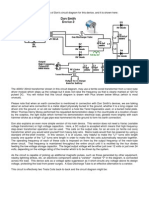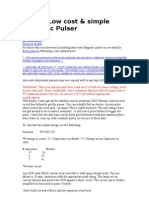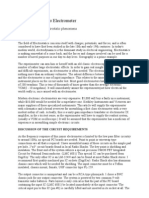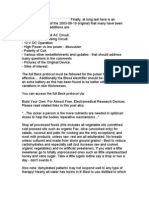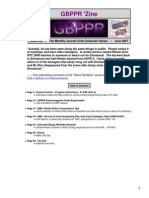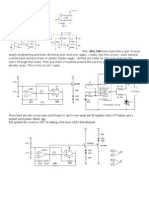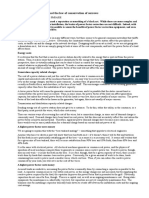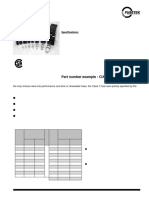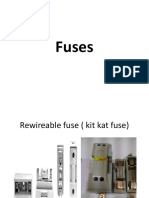0 ratings0% found this document useful (0 votes)
110 viewsIonosphere Static Electricity Converter
Ionosphere Static Electricity Converter
Uploaded by
Ayodele OyedeleThis document describes an emergency battery charging system that harnesses static electricity from the atmosphere. It can charge a backup battery without solar panels, generators or other power sources. The system uses a long insulated wire as an antenna to capture static electricity. A spark plug discharges the static electricity into an ignition coil, which pulses the low-voltage charge into a marine battery. Weather conditions that increase static electricity, like wind and cold, improve the system's performance. With over 200 feet of wire, the system can fully recharge a 12-volt battery every 2-3 days using only atmospheric static.
Copyright:
© All Rights Reserved
Available Formats
Download as PDF, TXT or read online from Scribd
Ionosphere Static Electricity Converter
Ionosphere Static Electricity Converter
Uploaded by
Ayodele Oyedele0 ratings0% found this document useful (0 votes)
110 views3 pagesThis document describes an emergency battery charging system that harnesses static electricity from the atmosphere. It can charge a backup battery without solar panels, generators or other power sources. The system uses a long insulated wire as an antenna to capture static electricity. A spark plug discharges the static electricity into an ignition coil, which pulses the low-voltage charge into a marine battery. Weather conditions that increase static electricity, like wind and cold, improve the system's performance. With over 200 feet of wire, the system can fully recharge a 12-volt battery every 2-3 days using only atmospheric static.
Original Description:
converting free energy
Copyright
© © All Rights Reserved
Available Formats
PDF, TXT or read online from Scribd
Share this document
Did you find this document useful?
Is this content inappropriate?
This document describes an emergency battery charging system that harnesses static electricity from the atmosphere. It can charge a backup battery without solar panels, generators or other power sources. The system uses a long insulated wire as an antenna to capture static electricity. A spark plug discharges the static electricity into an ignition coil, which pulses the low-voltage charge into a marine battery. Weather conditions that increase static electricity, like wind and cold, improve the system's performance. With over 200 feet of wire, the system can fully recharge a 12-volt battery every 2-3 days using only atmospheric static.
Copyright:
© All Rights Reserved
Available Formats
Download as PDF, TXT or read online from Scribd
Download as pdf or txt
0 ratings0% found this document useful (0 votes)
110 views3 pagesIonosphere Static Electricity Converter
Ionosphere Static Electricity Converter
Uploaded by
Ayodele OyedeleThis document describes an emergency battery charging system that harnesses static electricity from the atmosphere. It can charge a backup battery without solar panels, generators or other power sources. The system uses a long insulated wire as an antenna to capture static electricity. A spark plug discharges the static electricity into an ignition coil, which pulses the low-voltage charge into a marine battery. Weather conditions that increase static electricity, like wind and cold, improve the system's performance. With over 200 feet of wire, the system can fully recharge a 12-volt battery every 2-3 days using only atmospheric static.
Copyright:
© All Rights Reserved
Available Formats
Download as PDF, TXT or read online from Scribd
Download as pdf or txt
You are on page 1of 3
Emergency Power from Atmospheric Static Electricity
Charles (KC8VWM) on September 21, 2004
View comments about this article!
Emergency Power - Survival Style
What would you say if I told you it is possible to build an effective simple battery
charger for an emergency backup battery that is cheap, has no moving parts, has
no generator, works day or night, and has no solar cells and when weather
conditions worsens, the better it works?
What if we could harness this free energy and use it to our advantage after an
emergency event such as a large-scale power blackout, or after a hurricane
when we have no other methods at our disposal to charge our emergency
batteries after such an event occurs?
What if I told you that most hams already have the main components of this
charging system already installed at their operating locations?
Most all of us have learned to pick up our coax and to tap the PL-259 connector
against the case of the radio or ground to bleed off this charge before connecting
it to our radio equipment.
How few of us have ever been forced into a situation to have to think about how
we can turn this everyday static problem into free energy?
It is a well-known fact that enormous charges can build up on long wire antennas
and the longer the wire the more charge that it will build. Most hams think of this
as a disadvantage. I would like to further explore the possibility of how we can
turn this into a distinct advantage for both emergency backup power and
wilderness radio energy requirements.
I know that our antennas are supposed to intercept the vertical DC current
coming down from the sky. This typically represents a high voltage at a few micro
amps (the higher up your antenna is located off the ground, the higher the
voltage values on your antenna.)
We can further validate this information by trying this little experiment that only a
ham operator would actually be caught doing:
First let's hook up an NE-2 bulb from the antenna to ground, and then watch the
bulb in a dark room. It should start blinking repeatedly. Once you see the bulb
flashing, try hooking a few more NE-2 bulbs in series to determine how much
power your antenna wire can produce. For those that may not be sure what an
NE-2 bulb might look like, here is a photo at this link:
http://www.kenselectronics.com/picture3/ne2.jpg
You can "approximate" the voltage available by adding more NE-2 light bulbs into
the circuit chain until they won't flash anymore.
In this experiment, we can assume that each bulb adds about 100V to the trigger
voltage. If you can persuade a series chain of 10 bulbs to blink, then your
antenna is probably putting out at least several hundred volts, maybe even a
1000V!
Let's start this project by choosing a good marine battery. Marine batteries will
typically hold a charge longer than regular car batteries. Regular car batteries
can loose a charge just sitting around at a rate of almost 2 amps a day This
means precious backup power will be literally lost into thin air! Our objective in
this situation is to store as much emergency backup power in reserve as
possible, for the longest period of time possible.
Generally speaking, batteries that are rated in "reserve minutes" will typically
outlast batteries that are rated in "crank amps."
Next you will need a working spark plug. I prefer the V groove type, but any old
spark plug will work just fine. Start by hooking up the spark plug tip to the end of
your antenna wire (antenna wire described later) and then run the ground end of
the spark plug (where the threads are) into the top cap of a 12-volt automotive
coil. Any old salvaged working coil will do. (Of course, except for the one your
wife currently uses in her car.)
It is important to choose only insulated antenna wire for this project, as this will
work best. The wire should be completely insulated from end to end with no
breaks or soldered connections anywhere in-between. It doesn't seem to make
any difference whether you lay it out in a straight line, is a looped antenna
configuration, or if it weaves back and forth. Length is the key, not its footprint
size.
Old discarded phone line, old cable TV coax, practically any wire that is insulated
and long will provide satisfactory results provided that you don't tear the
neighbor's cable TV wire out of his lawn, you shouldn't have any problems using
any type of insulated wire for this project.
To connect the coil to the battery, we will use the bottom connector of the
automotive coil that is normally connected to the points in your car. This will now
be connected to the positive side of your emergency battery. The negative post
of the battery is simply hooked up to a good earth ground.
You can make this work in field, wilderness or portable radio operations by
driving a temporary ground rod into the earth and then connect the ground
directly to the negative post on your battery.
Next we install a 1 to 3 KV capacitor. The capacitor value will work best if it is
around a few pico-farads like those typically found in the horizontal section of a
television chassis. The capacitor is then connected from ground back to the wire
where the top of the spark plug is connected to the antenna.
Nothing should be touching ground except the ground post of the battery.
Approx. 200 feet of insulated wire will completely charge a 12 volt deep cycle
every 2 or 3 days! A thousand feet of wire will do it a lot quicker but the voltages
will approach lethal levels.
This works as a charging system because the long antenna wire acts like a
capacitor building an electric charge on the antenna wire. When a few thousand
volts are reached, it will be discharge by "sparking" across the spark plug. The
spark plug then delivers the electric charge to the coil, which in turn "down-
converts" it to a few hundred volts. The electricity is then injected into the battery
from the coil. The coil works by "pulsing" the charge into the battery at regular
discharge intervals.
The weather controls how much static electricity is in the air at any given time
during the course of the day or night. This electricity is then made available for
charging our battery.
The real advantage of this particular charging system during an emergency
situation is that the worst the weather gets, the more electricity you will have at
your disposal for charging your battery.
When conditions such as wind and super cold air are frequently persistent, you
will be able to weld the fillings in your teeth together! ...Be careful!
The higher you get the insulated wire of the ground, the better it will work in
capturing DC current from the air for this highly effective, but low cost emergency
battery charging system.
73
Charles - KC8VWM
You might also like
- A Wind Turbine Recipe Book 2014 English Units EdtionFrom EverandA Wind Turbine Recipe Book 2014 English Units EdtionRating: 5 out of 5 stars5/5 (2)
- KabbalahDocument30 pagesKabbalahprimeroson2102100% (4)
- Power of PrayerDocument110 pagesPower of PrayerPompy Joe100% (3)
- MV Cable Sizing SheetDocument2 pagesMV Cable Sizing SheetRa Ar100% (4)
- Build Your Own Portable Power Station: An Arfcom Tutorial (Very Pic Heavy)Document10 pagesBuild Your Own Portable Power Station: An Arfcom Tutorial (Very Pic Heavy)John MillerNo ratings yet
- Zilano 2Document22 pagesZilano 2blargbl100% (5)
- Build A Low Cost Magnetic PulserDocument10 pagesBuild A Low Cost Magnetic PulserHaSophim100% (7)
- Simple Free-Energy Devices: Chapter 21: A Perpetual LightDocument18 pagesSimple Free-Energy Devices: Chapter 21: A Perpetual LightbluesurviverNo ratings yet
- Simple Free Energy DevicesDocument1 pageSimple Free Energy Devicesguy richard atouabyNo ratings yet
- Joule Thief CircuitDocument8 pagesJoule Thief CircuitTariq PatelNo ratings yet
- Flyback Driver CircuitoDocument15 pagesFlyback Driver CircuitoCarlos Sarmiento LoraNo ratings yet
- Simple Free-Energy Devices: Chapter 4: The "Alexkor" CircuitsDocument7 pagesSimple Free-Energy Devices: Chapter 4: The "Alexkor" CircuitsRafat Kashoom100% (3)
- How To Use An Ignition CoilDocument3 pagesHow To Use An Ignition CoilAjay J. VERMANo ratings yet
- A Perpetual LightDocument7 pagesA Perpetual Lightsuherlan endan100% (1)
- GBPPR 'Zine - Issue #65Document58 pagesGBPPR 'Zine - Issue #65GBPPRNo ratings yet
- Virtual Ground CircuitsDocument11 pagesVirtual Ground CircuitsRahul DevaNo ratings yet
- Amrutvahini College of Engineering, Sangamner  Œ 422608Document12 pagesAmrutvahini College of Engineering, Sangamner  Œ 422608Rajesh KumarNo ratings yet
- Free Energy From Thin Air!: InstructablesDocument18 pagesFree Energy From Thin Air!: Instructables3DSツTRĪCKSHØT100% (1)
- 4 Zagreb - Generator InfosDocument6 pages4 Zagreb - Generator InfosZoran ConstantinescuNo ratings yet
- How To Build Your Own Uninterruptible Power SupplyDocument17 pagesHow To Build Your Own Uninterruptible Power Supplymaster chibukingNo ratings yet
- Wireless Power Transmission Using Resonance CouplingDocument6 pagesWireless Power Transmission Using Resonance CouplingKarthik Dm100% (1)
- An Experimenters ElectrometerDocument5 pagesAn Experimenters Electrometerdennis6171No ratings yet
- Environmental Sustainable - Free EnergyDocument31 pagesEnvironmental Sustainable - Free EnergyshawnleegabrielNo ratings yet
- Tesla Coil ConstructionDocument4 pagesTesla Coil Constructiondllabarre100% (2)
- Tesla Coil Construction Article PDFDocument4 pagesTesla Coil Construction Article PDFscribdmoonNo ratings yet
- Secret of OverunityDocument4 pagesSecret of Overunitycheikh Ahmed100% (3)
- GBPPR Electromagnetic Pulse Experiments - Part 1Document19 pagesGBPPR Electromagnetic Pulse Experiments - Part 1tutankamon20010No ratings yet
- Inverter QuestionsDocument4 pagesInverter Questionssuhaibmasroor1No ratings yet
- PowerLabs Flyback DriverDocument8 pagesPowerLabs Flyback DriverJayam SonaniNo ratings yet
- Interview QuestionsDocument13 pagesInterview Questionspratham sutharNo ratings yet
- Convert ATX To DC Power SupplyDocument15 pagesConvert ATX To DC Power SupplyRendy Alfiq0% (1)
- Wireless ChargingDocument31 pagesWireless ChargingAbhinav Raj100% (1)
- (UPDATED) Compilation of Important Info Don Smith Shared To NuEnergy Yahoo GroupDocument13 pages(UPDATED) Compilation of Important Info Don Smith Shared To NuEnergy Yahoo Groupjubeng100% (1)
- Dipole Antenna BasicsDocument3 pagesDipole Antenna BasicsEmil PatrickNo ratings yet
- Questions: Will Solar Work in My Location?Document4 pagesQuestions: Will Solar Work in My Location?Mario AlbertoNo ratings yet
- How To Build A Tube AmpDocument12 pagesHow To Build A Tube AmpBernie Connarty100% (3)
- High Voltage 'Non-Persistent' Fault Finding Cable and Cable Fault Locating - Part 4Document4 pagesHigh Voltage 'Non-Persistent' Fault Finding Cable and Cable Fault Locating - Part 4Niyaz JaleelNo ratings yet
- Solar Off GridDocument6 pagesSolar Off Gridmarktaborete0No ratings yet
- Low-Power Wireless Charging: Gripen40kDocument4 pagesLow-Power Wireless Charging: Gripen40kEr Ajay PatelNo ratings yet
- Aterramento Da EstaçãoDocument185 pagesAterramento Da EstaçãoAnízio Luiz Freitas de MesquitaNo ratings yet
- A Simple Way To Test Capacitors PDFDocument7 pagesA Simple Way To Test Capacitors PDFmilan_lahiru100% (1)
- Controlling Radiated EMI Through PCB Stack-Up: Rick HartleyDocument7 pagesControlling Radiated EMI Through PCB Stack-Up: Rick HartleyLungu CristianNo ratings yet
- Build A Low Cost & Simple Magnetic PulserDocument36 pagesBuild A Low Cost & Simple Magnetic PulserWb Warnabrother Hatchet100% (1)
- The Electricity Honor Is A Component of TheDocument7 pagesThe Electricity Honor Is A Component of TheJun Siguenza AmbrocioNo ratings yet
- Grounding Noise Presentation Jan 20 2014Document36 pagesGrounding Noise Presentation Jan 20 2014augur886No ratings yet
- LAN Cable TesterDocument5 pagesLAN Cable Testerngeorgotas4230No ratings yet
- ZapperDocument3 pagesZapperawemetal0% (1)
- The Strobe Light Effect (Levitating Water ExperiDocument6 pagesThe Strobe Light Effect (Levitating Water Experiro nitNo ratings yet
- Investegatory Project Physics Tesla CoilDocument24 pagesInvestegatory Project Physics Tesla Coilyuukamiya672No ratings yet
- GBPPR 'Zine - Issue #38Document70 pagesGBPPR 'Zine - Issue #38GBPPRNo ratings yet
- Household Circuits - STD 10Document5 pagesHousehold Circuits - STD 10yashwantnayak61No ratings yet
- Led CircuitsDocument18 pagesLed CircuitsDedan Kimathi100% (1)
- Ground Loops - by Kent English (Pass Labs)Document3 pagesGround Loops - by Kent English (Pass Labs)Marius BaltariuNo ratings yet
- Strobe Troubleshooting GuideDocument5 pagesStrobe Troubleshooting Guide1dsmark27088No ratings yet
- 023 - ABBPowerfactorDocument3 pages023 - ABBPowerfactorHacen ZehaniNo ratings yet
- A Complete Guide To Battery ChargingDocument4 pagesA Complete Guide To Battery ChargingAman SinghNo ratings yet
- Wiring A Ring MainDocument2 pagesWiring A Ring MainApollyonNo ratings yet
- Portable & Wireless Power Transfer: Sub. By:-Anwar Khan Junaid Azad Amit KumarDocument12 pagesPortable & Wireless Power Transfer: Sub. By:-Anwar Khan Junaid Azad Amit KumarAamir YatooNo ratings yet
- Emp 400Document5 pagesEmp 400Ishwar SharmaNo ratings yet
- Surge ProtectionDocument15 pagesSurge Protectionjacques7474No ratings yet
- Essential Boat Electrics: Carry Out Electrical Jobs On Board Properly & SafelyFrom EverandEssential Boat Electrics: Carry Out Electrical Jobs On Board Properly & SafelyNo ratings yet
- Static-Inverter 1.0: A Complete Design Process to Convert D.C. to A.C. Electricity Using the Astable-MultivibratorFrom EverandStatic-Inverter 1.0: A Complete Design Process to Convert D.C. to A.C. Electricity Using the Astable-MultivibratorNo ratings yet
- Ana BChoachDocument1 pageAna BChoachAyodele OyedeleNo ratings yet
- The Act of Making MoneyDocument34 pagesThe Act of Making MoneyAyodele OyedeleNo ratings yet
- 50 Ideas That Can Change Your LifeDocument88 pages50 Ideas That Can Change Your LifeKristina Mirzac100% (5)
- How To Build A Zpe Research Lab at Your Home: Electronics and Tools You Are Going To NeedDocument25 pagesHow To Build A Zpe Research Lab at Your Home: Electronics and Tools You Are Going To Needvictor muntean100% (1)
- Netrex Radionics ManualDocument40 pagesNetrex Radionics ManualAyodele Oyedele100% (1)
- Lightning and Surge Protection For Rooftop Photovoltaic SystemsDocument20 pagesLightning and Surge Protection For Rooftop Photovoltaic SystemsRobson Quirino100% (2)
- SG33CX/SG40CX/SG50CX: Multi-MPPT String Inverter For SystemDocument2 pagesSG33CX/SG40CX/SG50CX: Multi-MPPT String Inverter For SystemHenrique EllerNo ratings yet
- Calculation For CTs Used in Differential ProtectionDocument7 pagesCalculation For CTs Used in Differential ProtectionRebekah PowellNo ratings yet
- Simbol Diagram Listrik (Full Page)Document30 pagesSimbol Diagram Listrik (Full Page)Saswita SaktiNo ratings yet
- Guía de FusiblesDocument11 pagesGuía de FusiblesbtoroNo ratings yet
- Laptek Form CB 11KV MVDocument1 pageLaptek Form CB 11KV MVDian PermanaNo ratings yet
- Current Transformer Notes PDFDocument5 pagesCurrent Transformer Notes PDFAyush Saxena100% (1)
- Fusetek 65U CatalogDocument72 pagesFusetek 65U Catalogprocrastinateur99No ratings yet
- 450 857 07 C44CL Memcom Otis REM6 Wiring Loom V02 MLDocument8 pages450 857 07 C44CL Memcom Otis REM6 Wiring Loom V02 MLsam11No ratings yet
- 6 Electrical Tests For Current Transformers Explained PDFDocument23 pages6 Electrical Tests For Current Transformers Explained PDFWasif AwanNo ratings yet
- "Mechanical Measurements" T. Beckwith, R. Marangoni, and J. Lienhard, Sixth Edition, Pearson Prentice Hall 2009Document2 pages"Mechanical Measurements" T. Beckwith, R. Marangoni, and J. Lienhard, Sixth Edition, Pearson Prentice Hall 2009Timothy FieldsNo ratings yet
- New Feeder Automation TechniqueDocument67 pagesNew Feeder Automation TechniqueSyahrul MakkuassangNo ratings yet
- EN (IEC) 61439 1 - 2 - en PDFDocument27 pagesEN (IEC) 61439 1 - 2 - en PDFasimjkhanNo ratings yet
- Selection of Main & Branch Circuit Breaker For Distribution Box (As Per NEC)Document9 pagesSelection of Main & Branch Circuit Breaker For Distribution Box (As Per NEC)mof98009No ratings yet
- The Grid Tie Solar Panel SystemDocument3 pagesThe Grid Tie Solar Panel SystemphilnavfacNo ratings yet
- 12V DC Intrinsically Safe Power Supply: Technical Datasheet Technical DatasheetDocument2 pages12V DC Intrinsically Safe Power Supply: Technical Datasheet Technical DatasheetProcurement PardisanNo ratings yet
- Control Cable Net RequirmentDocument8 pagesControl Cable Net RequirmentMilind DombaleNo ratings yet
- GCS-VSD Course HSEDocument20 pagesGCS-VSD Course HSEMohamed MostafaNo ratings yet
- PM Motor: Reference CharacteristicsDocument1 pagePM Motor: Reference CharacteristicsJaime Adolfo Mejia LeónNo ratings yet
- 7-Segment DisplayDocument6 pages7-Segment DisplayPriyanka AroraNo ratings yet
- Problems On AC Drives PDFDocument2 pagesProblems On AC Drives PDFAbbas NizamNo ratings yet
- Schneider Electric Circuit Breaker Trafo 1600 KvaDocument3 pagesSchneider Electric Circuit Breaker Trafo 1600 Kvaeri21No ratings yet
- Stator Resistance and Auto Transformer StarterDocument5 pagesStator Resistance and Auto Transformer StarterRAMAKRISHNA PRABU GNo ratings yet
- Chapter 22 - Electromagnetic Induction: Pre-U Text Physics Volume 2Document3 pagesChapter 22 - Electromagnetic Induction: Pre-U Text Physics Volume 2khaiNo ratings yet
- Unit-1 FusesDocument27 pagesUnit-1 FusesREDAPPLE MEDIANo ratings yet
- Kisi2 UKP ETODocument6 pagesKisi2 UKP ETOFahad AbdullohNo ratings yet
- DRAWING LIMIT N 9403.624: Saudi Arabian Oil CompanyDocument1 pageDRAWING LIMIT N 9403.624: Saudi Arabian Oil CompanybillNo ratings yet
- 1SCC303003M0205 PDFDocument156 pages1SCC303003M0205 PDFSopian PianNo ratings yet
- EC-C Resolver Configuration 11.1Document15 pagesEC-C Resolver Configuration 11.1MostafaElrakhawyNo ratings yet





